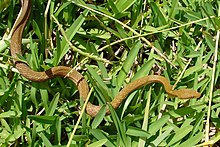Wildlife of Seychelles
In common with many fragile island ecosystems, the early human history of Seychelles saw the loss of biodiversity including the disappearance of most of the giant tortoises from the granitic islands, felling of coastal and mid-level forests and extinction of species such as the Marianne white-eye, Seychelles parakeet, Aldabra brush warbler, and the saltwater crocodile.However, extinctions were far fewer than on other islands such as Mauritius or Hawaii, partly due to a shorter period of human occupation (since 1770).Dufresne instructed Duchemin, captain of the vessel La Digue, to "especially give the greatest attention to the study and prospects of all the species of inland productions such as trees, bushes, plants, herbs, quadruped animals, birds, insects, freshwater fish, stones, soil, minerals.Subsequent to settlement, Fairfax Moresby's hydrographic survey in 1822, was the first scientific study in the islands, while early collectors included Pervillé,[which?]Studies after Gardiner were sparse up to the 1950s, though some residents of Seychelles made valuable contributions, notably Dupont,[which?]conducted a major study of marine fish, while Jacques Cousteau also visited in 1954 aboard the RV Calypso.The contribution of Royal Society to the knowledge of Aldabra from 1966 is legendary and work on Aldabra continued under the custodianship of Seychelles Islands Foundation In more modern times, International Council for Bird Preservation (ICBP, now BirdLife International) conducted a great deal of research on Cousin Island.Although many of the conservation laws date back to British colonial days, the Seychelles government has strictly protected the natural heritage of the islands for many years.Sometimes nicknamed the "love nut" because of its suggestive shape, the coco de mer is the world's largest seed.Other unique plant species include the Rothmannia annae found only on Aride Island Special Reserve.Since the use of spearguns and dynamite for fishing was banned through efforts of local conservationists in the 1960s, the wildlife is unafraid of snorkelers and divers.The granitic Seychelles are home to the country's only true freshwater crab, Seychellum alluaudi, which is endemic to the archipelago.





Vallée de MaiPraslinSeychellesAfricaIndian Oceanendemiccoco de merNepenthes pervilleiSilhouetteloss of biodiversitygiant tortoisesMarianne white-eyeSeychelles parakeetAldabra brush warblersaltwater crocodileMauritiusHawaiiMarion DufresneFairfax MoresbyPercy SladenJacques CousteauRV CalypsoRoyal SocietyAldabraSeychelles Islands FoundationBirdLife InternationalCousin IslandAride IslandRoyal Society of Wildlife TrustsIsland Conservation SocietyRamos National ParkNature Protection Trust of SeychellesAldabrachelys giganteaSeychelles giant tortoiseUNESCOWorld Heritage SitesGarden of EdenecotourismSainte Anne Marine National ParkparastatalWorld BankNorth IslandCurieusejellyfish treeRothmannia annaeLodoicea maldivicaDeckenia nobilisNephrosperma vanhoutteanumPhoenicophorium borsigianumRoscheria melanochaetesVerschaffeltia splendidapalm treesSeychelles wolf snaketortoisesAldabrachelysSeychelles giant tortoisesArnolds giant tortoisespeciesNature SeychellesFregateSeychelles black parrotAldabra drongoSeychelles magpie robinSeychelles paradise flycatcherSeychelles fodySeychelles scops-owlSeychelles white-eyeSeychelles swiftletSeychelles kestrelSeychelles blue pigeonSeychelles bulbulSeychelles warblerSeychelles sunbirdCosmoledosooty ternnoddiesfrigatebirdsspeargunsdynamiteCoral bleachingSilhouette Islandterrestrial or semi-terrestrial crabshermit crabcoconut crabfreshwater crabSeychellum alluaudicaecilianPraslin's caecilianFrigate Island caecilianGrandisoniageckosskinksMadagascar girdled lizardchameleonArchaius tigrisList of birds of the SeychellesList of mammals in the SeychellesList of amphibians of SeychellesList of non-marine molluscs of the SeychellesSpringerarticlesHistoryHistory of SeychellesColonial governors1977 coup d'état1981 coup d'état attemptGeographyCapitalCitiesIslandsDistrictsRiversPoliticsElectionsForeign relationsLGBT rightsMilitaryNational AssemblyPolitical partiesPresidentVice-PresidentPrime MinisterSupreme CourtEconomyAgricultureCentral Bank